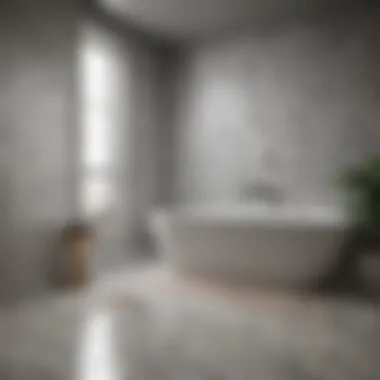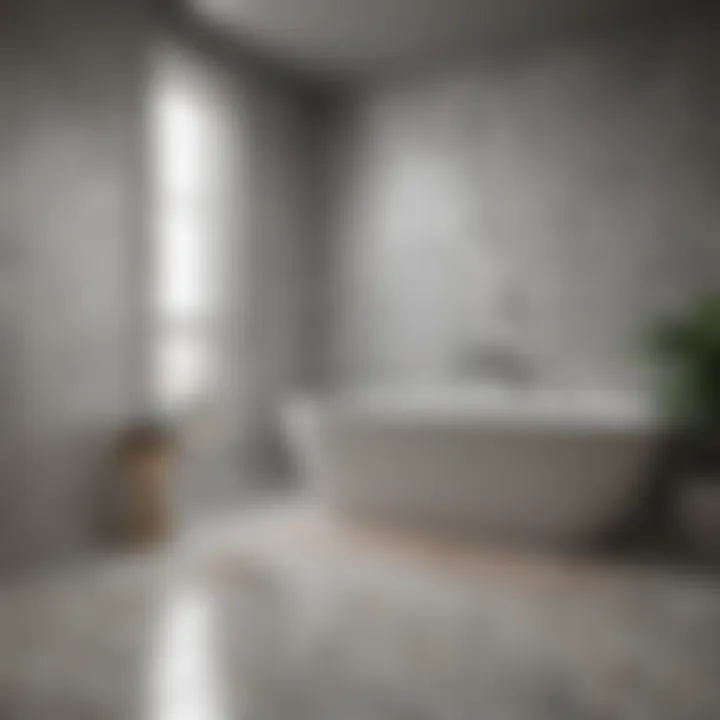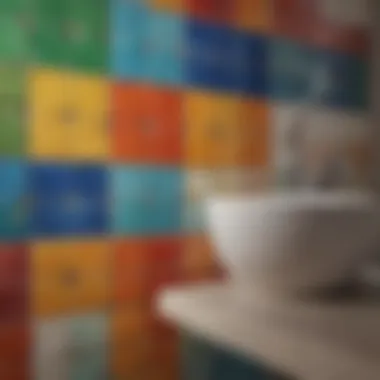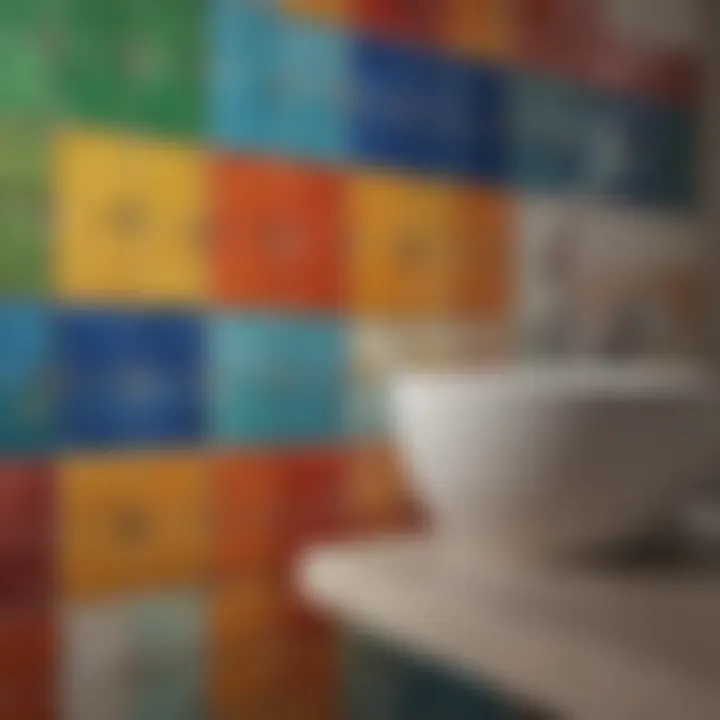Creative Tile Ideas for Small Bathrooms in 2021


Intro
In a world where home spaces are becoming increasingly compact, the design of small bathrooms poses a unique challenge. Homeowners and design enthusiasts alike seek solutions that marry functionality with style, all while navigating the constraints of limited square footage. This article breaks down innovative ideas for small bathroom tiles that emerged in 2021, emphasizing trends, materials, colors, and patterns. Whether you're looking to refresh your aesthetic or completely remodel, these insights promise to enhance your bathing oasis.
A bathroom, despite its small size, plays a crucial role in a home. It's a space for relaxation, self-care, and daily routines. Thus, the tiles you choose not only impact the overall design but also the ambiance and functionality of the space. With that in mind, let’s explore the various aspects of tile design that can revolutionize your compact bathroom.
Interior Design Tips
When it comes to designing small bathrooms, every inch counts. Selecting the right tile can make or break the illusion of space. Here are some effective strategies:
- Opt for Larger Tiles: While it might seem counterintuitive, using fewer larger tiles can actually create a sense of spaciousness. Large format tiles reduce the number of grout lines, which visually expands the area.
- Vertical Installation: Lay tiles in a vertical pattern. This can give the illusion of height, drawing the eyes upward and creating a more open feeling.
- Reflective Surfaces: Glossy tiles or those with a glass-like finish can bounce light around, brightening up your little sanctuary.
"The right tiles can transform a cramped space into a serene retreat."
Moving beyond just the tile material or color, the overall design of a bathroom is also influenced by the interaction of these tiles with other elements in the room, such as fixtures and lighting.
Trendy Design Ideas
A few noteworthy designs that took center stage in 2021 include:
- Mix and Match Patterns: Combining different patterns can infuse character into an otherwise bland bathroom. Geometric shapes alongside floral designs can offer a modern yet inviting ambiance.
- Mosaic Accents: Consider including a splash of vibrant mosaic tiles in specific areas, like the shower niche or behind the sink. This not only adds visual interest but can also serve as a focal point.
- Natural Textures: Tiles that mimic natural materials, such as wood or stone, provide warmth and an organic touch, making the space feel more grounded.
Color Schemes and Combinations
Color is a powerful tool in design, especially in smaller spaces. Here are some palettes that work wonders:
- Light and Bright: Soft whites, pale blues, and light greys can make a bathroom feel airy and expansive.
- Bold and Beautiful: A single dramatic wall in deep navy or emerald can act as an unexpected pop, allowing the rest of the area to remain neutral.
- Earth Tones: Incorporating browns and greens can bring a sense of nature indoors, proving soothing and inviting.
Syntheiszing Ideas
To wrap it all up, creating a stylish yet functional small bathroom is achievable by thoughtfully selecting your tile choices. From embracing larger formats to experimenting with unique color combinations, the right tile can uplift your space without cluttering it further. As you embark on your design journey, remember to keep space and light in mind. Believe me, the smallest spaces can tell the most compelling stories with the right design approach.
Understanding the Importance of Tile Selection
Selecting tiles for a small bathroom is not just about aesthetics; it sets the tone for the entire space. With the right choices, you can transform an otherwise insignificant area into a stylish retreat. Tile selection plays a pivotal role in dictating not only how a bathroom looks but also how it functions.
When thinking about aesthetics, consider that tiles carry the essence of your design vision. They can elevate simple bathrooms into spaces of luxury. Who wouldn’t want to step into a room that feels open and inviting? Contour and color are key players here. Bright, light colors can add an illusion of space, while bolder hues can serve as striking focal points.
Factors to contemplate in your selection process include texture, size, and layout. Textures can enliven a space, offering a feeling of depth which is crucial in cramped areas. The size of the tiles is another significant matter; larger tiles can create a seamless look, making the room feel bigger, while smaller tiles provide versatility and can be used creatively in intricate patterns.
Importantly, though style matters, functionality shouldn't be tossed aside. A well-chosen tile can withstand the destruction of moisture and heavy foot traffic, which is particularly important in bathrooms. Durability and maintenance ease are vital factors, especially when it comes to cleaning and long-term wear.
In the following subsections, we will dissect tile selection, delving into: the role tiles play in bathroom aesthetics, and the functionality and maintenance considerations that come with them, giving you all the info you need to make an informed choice.
Exploring Tile Trends
The realm of bathroom design is ever-changing, and keeping up with the latest tile trends is essential, especially for small spaces. The relevance of exploring these trends lies not only in aesthetic appeal but also in enhancing the functionality and overall ambiance of your bathroom. For homeowners and design enthusiasts, being aware of current tile innovations empowers better decisions that reflect personal taste while maximizing small areas.
Tile trends in 2021 emphasize sustainable materials, vibrant colors, and textured surfaces, catering to diverse styles and preferences. Whether you want to go bold with colors or stick to classic neutrals, understanding these options can greatly influence your space's visual depth and functionality.
Sustainable and Eco-Friendly Options
Recyclable Materials
Recyclable materials have taken the design world by storm, particularly in bathroom tile applications. This eco-friendly approach speaks to a growing awareness about environmental impact. Tiles made from recycled glass or ceramics reduce waste and showcase stunning aesthetics via unique textures and colors. These materials not only serve a practical purpose but also convey a commitment to sustainability that resonates well with a conscientious audience.
One significant feature of recyclable materials is their versatility. They can mimic natural stones or traditional ceramic tiles, making them a fashionable choice without compromising style for sustainability. In a small bathroom, these tiles can enhance the overall design narrative, turning waste into a work of art. However, it’s important to keep in mind that while they can be durable, their maintenance could vary based on the material composition.
Bamboo and Cork Tiles
Bamboo and cork tiles have become frontrunners in sustainable options for bathrooms. What sets bamboo tiles apart is their rapid growth cycle and natural antibacterial properties. This makes them not only a healthier choice for your living space but also an attractive one with a warm, earthy aesthetic.
On the other hand, cork tiles,—lightweight yet resilient—offer excellent thermal insulation and sound absorption. They bring a sense of comfort to small bathrooms, contributing to a cozy and surprisingly sophisticated vibe. Just be mindful that cork requires proper sealing to prevent water damage, making upkeep a little more hands-on compared to traditional tiles.


Bold Colors and Classic Neutrals
Deep Blues and Greens
In 2021, deep blues and greens are making quite the splash in small bathroom spaces. These colors offer a sense of depth while creating an inviting atmosphere. By incorporating such shades, you can elevate your bathroom from mundane to a luxurious retreat. Deep blue tiles evoke feelings of tranquility and calmness, perfect for creating your personal oasis.
Furthermore, focusing on solid, bold colors can have an illusionary effect. When strategically placed, they create a sense of spaciousness in tight spots, allowing walls to recede visually, while lighter accents can highlight certain features, enhancing appeal. However, balance is key—too much of these hues can overwhelm a compact space.
Subtle Grays and Whites
Conversely, subtle grays and whites remain steadfast choices for timeless bathroom aesthetics. They exude sophistication and versatility, making them a popular choice among homeowners. This color palette allows for seamless integration with a range of other elements imaginable in a bathroom space.
Think of how white tiles brighten up a small room. They reflect natural light, making the area feel more open. Similarly, grays inject a contemporary flair while keeping things neutral. The unique aspect here is mixing finishes between matte and glossy—combining these elements can create layers of interest without clashing visually. On the downside, stains can be more prominent on white tiles, requiring regular maintenance to keep them looking pristine.
Textured Surfaces for Added Depth
3D Tiles
3D tiles are capturing the attention of design aficionados in 2021. Their tactile quality adds an engaging layer to bathroom walls. By breaking up flat surfaces, these tiles can transform ordinary spaces into dynamic environments. The dimensionality created by 3D designs draws the eye, allowing small bathrooms to exhibit character and uniqueness.
Additionally, the creativity of 3D tiles provides countless possibilities in terms of pattern and arrangement. This can turn a simple shower or backsplash into a focal point. Still, one must consider that cleaning such surfaces can be more cumbersome due to crevices that trap grime.
Matte Finishes
Lastly, matte finishes are enjoying their moment in small bathroom design. They offer an alternative to the shine of glossy tiles, bringing an understated elegance to spaces. Matte tiles diffuse light softly, preventing glare and giving a warm, inviting feel.
Their unique characteristic is how they can aid aesthetics while being practical; matte surfaces often hide fingerprints and smudges better than their glossy counterparts. However, there’s a trade-off—some matte tiles may be more porous, requiring careful sealing to avoid staining.
In summary, exploring tile trends in 2021 showcases a delightful blend of sustainability, color, and texture that helps create inviting spaces. Understanding these elements can ease the decision-making process for anyone looking to maximize their small bathroom's potential.
Tile Patterns and Layouts for Compact Spaces
When it comes to small bathrooms, the significance of tile patterns and layouts cannot be underestimated. Clever use of designs can not only enhance the appearance of tight quarters but also play a crucial role in making the space feel larger and more inviting. Patterns can draw the eye, creating illusions of depth and movement. Choosing the right layout often leads to a more functional space, conferring benefits that extend beyond mere aesthetics. For homeowners and enthusiasts alike, understanding these elements opens doors to innovative design possibilities.
Diagonal and Herringbone Patterns
Diagonal layouts are a striking choice for compact bathrooms. When tiles are placed at an angle rather than straight, they can create an impression of a more expansive area. This layout breaks up the monotony of standard designs, drawing eyes across the floor, and thereby minimizing the boxed-in feel of a small room.
The herringbone pattern, with its V-shaped arrangement, adds an unexpected yet sophisticated twist. This design can create visual drama, capturing attention while maintaining a classic charm. People often underestimate how much movement a cleverly arranged tile can lend to the space. The complexity of the herringbone design allows it to function both as a focal point and a backdrop, depending on the surrounding decor.
Grid and Subway Patterns
Grid patterns are timeless and work exceptionally well in small bathrooms. Tiles laid in a straightforward grid can offer a clean and orderly look, making a confined space feel organized and visually appealing. Using different colors or finishes within a grid can add a touch of creativity. For instance, alternating glossy and matte finishes within a grid can transform a mundane layout into something noteworthy.
Subway tiles, on the other hand, are the classic choice for walls and can effectively elongate a small area when arranged in a standard brick pattern. Their rectangular shape allows for flexibility in layout, providing seamless continuity from wall to wall, which can be particularly beneficial in compact bathrooms. This approach doesn’t just keep things tidy; it gives a subtle touch of elegance, making it a favorite among design enthusiasts.
Creative Borders and Accents
Borders and accents are where your creativity can shine without overwhelming a small space. Adding a decorative border of contrasting tiles can delineate different areas or simply elevate the aesthetic appeal. Borders can be as intricate or understated as desired; a thin line of glass tiles can introduce a luxurious feel, while a wide border might contribute to a more rustic charm.
Accents such as mosaics can draw attention and create a personal touch. They can be placed within a grid layout or used to frame specific features, like a mirror or vanity. By varying textures and colors in these accent pieces, you can enhance the visual narrative of the space, ensuring it views as fresh and inviting.
In summary, tile patterns and layouts play an essential role in transforming small bathrooms into functional, stylish retreats. Diagonal and herringbone patterns impart a sense of movement, while grid and subway tiles maintain a clean aesthetic. Creative borders and accents provide room for personalization and flair, making these elements critical considerations in your design blueprint.
Material Choices for Small Bathroom Tiles
When upgrading a small bathroom, the choice of tile material is crucial not just for visual appeal but also for practicality. Different materials bring their unique properties to the table, influencing durability, maintenance, and overall aesthetics. Choosing the right material can very much affect how the space feels; it can make a cramped room seem larger or, on the contrary, cozily inviting. Let’s break down the main contenders for bathroom tiles and understand their strengths and weaknesses.
Ceramic vs. Porcelain
Both ceramic and porcelain tiles are made from clay but differ significantly in composition and firing temperatures. Ceramic tiles are softer and more amenable to scratches and dents, while porcelain tiles are denser and more resistant to moisture, making them ideal for wet areas.
- Durability: Porcelain tiles are generally sturdier than ceramic tiles due to their higher firing temperature. If you're expecting high foot traffic or heavy impacts, porcelain might be your go-to choice.
- Moisture Resistance: In small bathrooms, where dampness is a given, opting for materials that resist water is essential. Porcelain tiles have a lower water absorption rate, making them ideal for shower spaces.
- Design Variety: Ceramic tiles offer a wide range of colors and designs, especially if you seek a specific pattern or texture. They can even mimic natural stones without the hefty price tag.
"When it comes to small bathroom tiles, the choice of material isn't just practical—it's a chance to express your personal style."


Natural Stone: Pros and Cons
Natural stone tiles add an undeniable elegance to any bathroom. With varieties like marble, granite, and slate, they can dramatically enhance the look of your compact space. However, there are some considerations to keep in mind:
- Aesthetic Appeal: Each stone tile has its unique veining and color patterns, bringing a luxurious feel. A small space with polished marble, for instance, can look quite opulent.
- Maintenance: Natural stones often require sealing to protect against moisture and stains. Unlike ceramic or porcelain, they can be more susceptible to damage from harsh cleaning products.
- Cost: The market price for natural stone can be steep, so budgeting becomes even more paramount, especially for larger projects.
Vinyl Tiles: Budget-Friendly Solutions
Vinyl tiles are akin to the unsung heroes of bathroom designs, particularly when finances are tight. Here's why they deserve a spot on your list of options:
- Affordability: Vinyl tiles are generally cheaper than ceramic or stone options. You'll often find quality choices that won't break the bank, enabling you to splurge on other areas, such as fixtures or decor.
- Installation: They’re usually easier to install, with a peel-and-stick option that can be a DIY project, saving additional labor costs.
- Water Resistance: Vinyl tiles are engineered to hold up against spills and moisture, hence are suitable for bathrooms.
Color Schemes That Enhance Space Perception
Choosing the right color scheme for small bathrooms is more than just a matter of aesthetics; it's also about creating an illusion of space. The colors you select can either open up the area or close it in, influencing how one perceives the dimensions of the room. Considerations such as the amount of natural light, tile finishes, and even the choice of fixtures play a crucial role in achieving a visually appealing and spacious environment.
When it comes to interior design, especially in smaller spaces, a light and bright color palette can work wonders. Bright colors tend to reflect light, which can give the illusion of a more expansive area. On the other hand, darker colors may absorb light, making a room feel more confined and shadowy. Thus, understanding the interplay of color with space perception is paramount when selecting tiles for your small bathroom.
Light and Bright Palettes
Light and bright palettes bring an uplifting charm to small bathrooms. Think soft pastels or crisp whites that brighten up the entirety of a space. These hues can make a bathroom feel airy and open, even when the square footage is modest. For instance, choosing ceramic tiles in soft blues or pale greens can evoke a sense of tranquility while visually expanding the room. Moreover, this approach also harmonizes well with natural light, making any sunshine that streams into your bathroom feel accentuated.
A few considerations when working with light and bright palettes include:
- Use Reflective Surfaces: Glossy tile finishes can enhance light reflection, further accentuating the spacious feel.
- Accentuate with White Grout: If you opt for brightly colored tiles, pairing them with white grout can create clean lines that enhance the perception of space.
- Limit Accent Colors: While it’s tempting to splash bold colors throughout, focusing on one or two accent colors gives a cleaner feel.
Monochromatic Schemes for Cohesion
Monochromatic schemes utilize varying shades of a single color, which can promote a sense of cohesion and fluidity. This approach allows for a streamlined look that can significantly flatter small bathrooms. A monochromatic palette is particularly effective because it simplifies the visual clutter, creating a seamless blend that appears larger than it is.
Choosing light variations of a single color can also generate depth without overwhelming the senses. For example, consider a range of light grays tiled together in a staggered pattern; this adds interest but remains visually calming.
- Textures Matter: Mixing textures within the same color family can bring visual interest without straying from the monochromatic theme. A matte finish paired with a glossy tile of the same shade can create an appealing contrast.
- Add Depth with Subtle Patterns: Utilizing patterned tiles in the same color can break monotony while maintaining cohesion.
In summary, choosing effective color schemes in small bathrooms is an art. It requires balancing light, color, and texture to create the illusion of spaciousness while ensuring the space remains aesthetically pleasing.
Integrating Tiles with Fixtures and Fittings
The relationship between tiles and bathroom fixtures is critical in crafting a cohesive aesthetic in small spaces. Done right, this integration not only enhances the functionality of your bathroom but also elevates the overall style without a doubt. When you consider tile choices alongside fixtures like sinks, faucets, and showerheads, you’re setting the stage for a space that feels harmonious and thoughtfully designed.
Key Elements to Consider:
- Style Compatibility: Tiles can dictate the tone of your bathroom. For instance, sleek and modern tiles may clash with vintage-style fixtures. It's a delicate balance—choosing tiles that complement rather than compete with your existing elements is vital for an appealing design.
- Color Coordination: Harmonizing colors between the tiles and fixtures creates a calming ambiance. A bright tile can energize a bathroom, but if the fixtures are too subtle, they may get lost in the mix. A careful eye ensures that all components work seamlessly together.
- Scale and Size: Fixtures can be large or small, which should dictate your tile selections. Large tiles may overpower smaller fixtures, while intricate small tiles can overwhelm a substantial vanity sink. Measurements should guide your choices to avoid any design missteps.
By merging tiles with fixtures, you facilitate a richer bathroom experience. It's not simply a functional aspect; it's where creativity meets practicality, making the small space more effective and enjoyable.
Balancing Tile Choices with Bathroom Fixtures
In a small bathroom, tile choices can either shine or fade based on the fixtures they accompany. A well-balanced visual effect can help the space feel larger and more inviting. First, consider the finish of your fixtures—are they matte, glossy, or textured?
- Matching finishes: For example, if you're opting for a matte dark tile, a matte black faucet would enhance the sophisticated vibe. On the contrary, a shiny tile paired with a matte fixture might feel disjointed.
- Contrast for Interest: Sometimes the best approach is to embrace variety. A bold, colorful tile can pop next to a more understated fixture. This contrast can attract the eye and produce an engaging visual rhythm. It’s all about striking the right balance—finding that sweet spot where you can let the tiles sing while still allowing the fixtures to play their part.
Using Grout Wisely for Visual Impact
Grout often gets overlooked in design discussions, but it plays a key role in the visual narrative of your bathroom. The right grout can highlight, blend, or contrast your tiles, making it a powerful tool in the design toolbox.
- Color Choices: White grout can create a uniform look, especially with small tiles, giving a seamless effect. On the flip side, dark grout can accentuate the design, drawing attention to the tile layout without overwhelming the space.
- Width of Grout Lines: Wider grout lines may suggest a rustic feel while narrow ones give a more polished look. This choice contributes greatly to the perceived size of the bathroom; narrow lines can enhance the impression of open space.
Practical Tips for Small Bathroom Tile Installation
Installing tiles in a small bathroom might seem like a daunting task, but with careful preparation and a systematic approach, you can achieve remarkable results. This section discusses practical tips for installation that can aid homeowners and design enthusiasts alike in transforming their compact spaces. Proper installation not only enhances the aesthetics but also boasts longevity, ultimately saving you money on repairs down the line.
Preparing the Surface and Planning Layout


Before laying a single tile, the surface preparation is crucial. A well-prepped surface is key for the tiles to adhere properly. Start by cleaning the area thoroughly to remove any dust or debris. It's also important to check for any unevenness. If the subfloor or wall surface is not level, you may need to patch or sand it down. Any bumps or dips can cause tiles to crack or shift over time.
Once the surface is ready, it’s time to plan your layout. Consider using a chalk line to mark where the tiles will go. This helps in visualizing the final installation. For small bathrooms, a popular technique is to center tiles on a focal point, like the sink or a mirror. This approach creates balance and draws the eye, making the space feel more organized.
- Prioritize the layout: Start from the center and work outwards. It allows for a more symmetrical appearance.
- Dry layout: Lay out a few tiles without adhesive before beginning the installation for a visual guide.
Dealing with Moisture and Temperature Variations
Moisture is an ever-present challenge in bathrooms. Since tiles are often subject to steam, humidity, and temperature changes, it’s essential to choose materials that are moisture-resistant. You might consider porcelain or ceramic tiles, which can withstand moisture better than other materials.
A reliable waterproof layer is also vital. Apply a moisture barrier—such as a sheet membrane or liquid waterproofing compound—before the tiles go down. This insulation protects both the subfloor and the walls from water damage.
Also, keep in mind that temperature variations, particularly in winter months, can impact both adhesive strength and grout. Tile adhesive will respond to temperature changes, so it’s best to work in moderate conditions. If the environment is particularly humid or cold, wait for a better day.
"Patience is key. Rushing through installation can lead to costly mistakes."
In summary, the installation of tiles in small bathrooms demands meticulous attention to detail. Preparing surfaces right and planning layouts smartly are foundational steps. Additionally, tackling moisture correctly ensures not only that your tiles stay put but that they contribute positively to the overall longevity and beauty of your bathroom.
Maintaining Small Bathroom Tiles
When it comes to small bathrooms, the tiles you choose can either make or break the space. Not only do tiles contribute to the aesthetic, but their maintenance can guide the longevity and comfort of your bathroom. Over time, grime, hard water stains, and even mildew can settle in, affecting both appearance and hygiene. Therefore, ensuring that your tiles are well-maintained is essential not just for beauty, but for functionality too.
A well-kept tile surface creates a welcoming atmosphere, while a neglected one can make even the most beautifully designed bathroom feel dingy and uninviting. Incorporating a consistent cleaning routine and knowing how to address common tile issues are critical for maintaining that fresh, pristine look.
Cleaning Techniques and Products
Selecting the right cleaning methods and products can set the tone for how your tiles will hold up over time. It's best to start with a gentle approach. Here are several actionable tips:
- Daily Maintenance: Wipe down shower tiles after use to prevent water spots and soap scum build-up. A simple microfiber cloth does the trick.
- Natural Cleaners: Consider mixing equal parts of vinegar and water for an effective, eco-friendly cleaning solution. Just spray, let it sit for a bit, and then wipe with a non-abrasive sponge.
- Specialized Tile Cleaners: For tougher stains or mildew, specialized tile cleaners can be employed. Brands like Zep or Scrubbing Bubbles offer products designed for tiles that do not harm the surface.
"A stitch in time saves nine" - This age-old saying rings true for tile maintenance. Tackling small issues before they snowball ensures a long-lasting tiled surface.
- Steam Cleaning: If you're facing persistent issues, using a steam cleaner might be the solution. It's effective at breaking down dirt, mold, and mildew without any harmful chemicals.
Understanding the right techniques can save time and money while keeping your bathroom looking sharp.
Addressing Common Tile Issues
Even with the best intentions, tiles may eventually face some challenges. Here are a few common issues and how to tackle them:
- Cracked Tiles: A crack not only looks unsightly but can also allow moisture to seep in. In most cases, replacing the cracked tile is necessary. Be sure to have spare tiles on hand from your original installation. It will save you headaches down the road!
- Grout Problems: Grout gets stained or discolored over time, particularly in wet areas. Regularly applying a grout sealer can help maintain its look and durability. If stains do appear, use an oxygen bleach cleaner or a paste made from baking soda and water to scrub them away.
- Mildew and Mold: The presence of mildew or mold often stems from humidity or poor ventilation. Using a good ventilation fan can mitigate this risk. Additionally, keeping caulk around the tub and sink areas clean and fresh helps prevent any mold from taking hold.
- Water Spots: Hard water can leave unsightly spots on tiles. Regularly cleaning tiles can help avoid this build-up, but if it forms, a solution of equal parts vinegar and water can often dissolve these stains with ease.
Consistency is key. Establishing a routine maintenance schedule not only prolongs the life of your tiles but enhances your overall bathroom experience.
Final Thoughts on Small Bathroom Tile Ideas
When considering bathroom design, the choice of tiles can feel a bit like finding the perfect piece in a puzzle. As we've explored the innovative tile ideas from 2021, it's clear that small bathrooms don’t have to skimp on style or functionality. Instead, they can serve as a canvas for creativity, merging practicality with aesthetics.
One crucial element is understanding how the right tiles can profoundly impact the overall vibe of a bathroom. Tiles serve not only as flooring or wall enhancements but also contribute to the mood and feel of the space. A well-selected tile can turn a cramped area into a more inviting and soothing retreat.
Choosing the Right Tile for Lasting Impact
The selection process for tiles is not merely about picking what looks good. It requires careful thought. Think of tile choices as investments—ones that can significantly affect both the value of a home and the experience of everyday life.
When selecting tiles, consider the following:
- Durability: In high-moisture areas, opting for materials such as porcelain or specific natural stones can ensure longevity.
- Texture and Feel: This aspect can influence not only appearance but also safety. Slip-resistant tiles can prevent accidents, especially in a small bathroom where space can be tight.
- Color and Light: Lighter shades can make small areas seem larger. For instance, using soft whites or light beiges can create an airy feeling. In contrast, bold colors might work best as accents, providing drama while keeping the space feeling open.
"Selecting the right tile is akin to choosing the soul of your bathroom—it defines the character and experience of the space."
Evolving Your Bathroom Aesthetics with Tile
Evolving aesthetics is an exciting aspect of home design; it allows for personal expression and adaptation to different styles through the years. Tiles offer unique opportunities for reinvention without extensive renovation.
Consider the new trends we explored earlier, such as sustainable materials or textured surfaces. These options are not just about functionality; they also reflect a homeowner's values and design aesthetic. For example, incorporating bamboo tiles can showcase a commitment to eco-friendliness while adding a natural touch.
Moreover, changing tiles occasionally can revamp the bathroom’s look entirely. Here are a few ideas:
- Seasonal Updates: Swap out decorative tiles to keep the room fresh with changing seasons.
- Accent Walls: Create a focal point using a striking tile pattern that draws the eye and sparks conversations.
- Mix and Match: Diversifying tile choices on the floor and wall can foster a layered, dynamic look.
The beauty of tile design is that it’s a reflection of who you are. It tells a story about your taste and preferences, making the bathroom not only a functional space but also a personal sanctuary.







